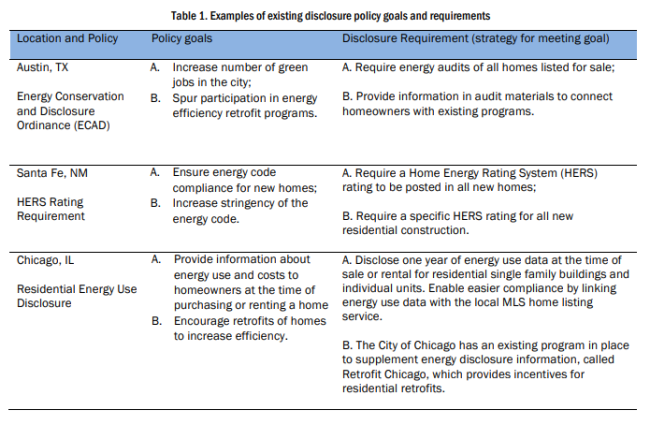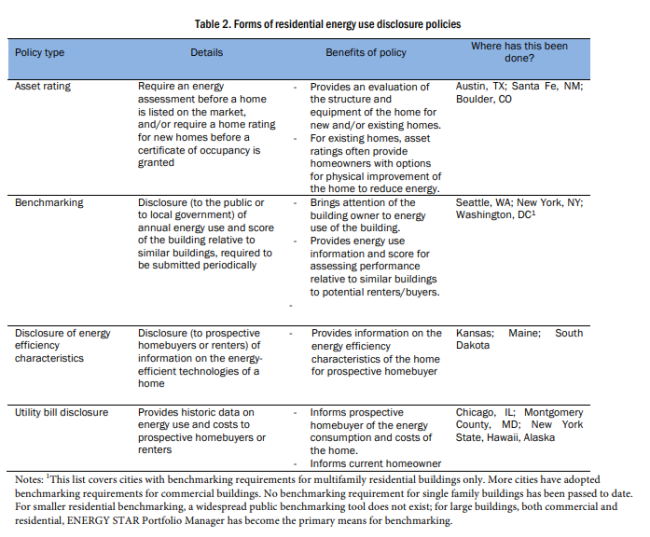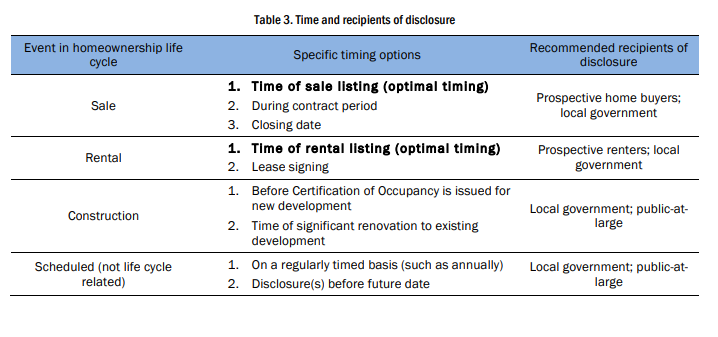A growing number of local and state governments are adopting policies requiring residential energy rating and/or disclosure, the practice of evaluating the energy efficiency of a home or building and making the information known to consumers. The option helps policymakers to enable energy reduction goals for buildings, and to increase transparency and consumer information around the home buying process. Policies requiring disclosure of energy use and benchmarking of commercial buildings are in place in nine large U.S. cities and one county, helping building owners understand where the greatest opportunities are for energy savings.[1] However, efforts targeted at the residential sector are less common and less uniform. Commercial and residential energy disclosure requirements share some characteristics and are sometimes implemented simultaneously, but this toolkit contains guidance most relevant to residential energy use disclosure. The toolkit provides an overview of existing residential disclosure efforts, and instructions on tailoring strategies to meet local policy objectives. It’s organized by these design and implementation steps:
- Confirm scope of local authority and gauge available resources
- Secure support from local stakeholders
- Decide on key components of a residential energy rating and disclosure policy
- Implement policy and track results
Why energy rating and disclosure and who does it involve?
Residential energy rating and disclosure is a promising low cost policy option that can help increase consumer transparency about the costs associated with operating a home, promoting more sound purchasing decisions in a post-mortgage crisis environment. Also, by quantifying building energy use, these policies can inform future policy and program efforts to reduce building energy consumption and track progress toward achieve community-wide climate and/or energy targets.
Energy rating and disclosure policies can involve the participation of a number of players, and those involved in the process can expect the following benefits:
- Homeowners will identify energy- and cost-saving priorities for home energy improvements, and receive a better valuation of existing energy efficiency features and improvements in the real estate market.
- Prospective homebuyers will gain more information about the operational costs of owning the houses under their consideration, and receive a better valuation of existing energy efficiency features and improvements.
- Policymakers will get more access to data on the energy use of the existing building stock, to both inform future policy development and track progress toward meeting local climate and/or energy reduction goals for buildings.
- Realtors will be better informed on documenting and quantifying how energy efficient a home is, allowing them to more confidently market energy efficiency features.
- The cross marketing of utility and disclosure programs can encourage homeowners to leverage energy efficiency programs to make improvements, helping utilities and other program operators to increase participation in energy efficiency programs, helping them to achieve program goals.
Depending upon the type and timing of the disclosure called for in a given policy, different participants will be responsible for making the actual disclosure. For example, realtors may be required to make the energy use disclosure during a home sale, or property owners may be required to disclose an asset rating developed by an energy service company (ESCO) to prospective rental tenants.
What approaches to energy disclosure have been used?
Different approaches to disclosure have been used to achieve various outcomes for cities depending upon cities’ goals and needs (table 1). Three examples of existing residential disclosure requirements indicate how a variety of approaches are helping to meet specific locality goals.

How To Develop a Residential Energy Disclosure Policy
I. Understanding Your Local Context and Resources
State and regional policies, the availability of efficiency programs, and the presence of a skilled workforce and experienced energy service companies can affect efforts to locally enact disclosure requirements. Before developing and drafting requirements, communities should explore the resources that may already be available.
Local Government Authority
Local governments need to consider what authority they have under state law to adopt a disclosure policy. The reach of local government authority varies throughout the country because states delegate differing degrees of autonomy to the communities within their borders.[2] Dillon’s Rule states allow communities to legislate only policy issues expressly allowed by the state constitution or those policy issues indispensable to being a community. Home Rule states grant more autonomy to communities to govern and implement policies. Some states borrow characteristics from both Dillon’s Rule and Home Rule. In many cases, communities in Dillon’s Rule states do not have the authority to mandate energy use disclosure requirements; they likely would have to lobby the state for authority to implement requirements.
Role of energy utilities
Consider existing utility and third party energy efficiency programs that are applicable to recipients of energy disclosure when developing a policy. Energy efficiency programs can be important complements to disclosure policies, spurring retrofit action and achieving actual energy savings. Marketing energy efficiency programs in conjunction with energy disclosure information can help link homeowners to resources from programs including contractor lists and financial incentives.
A policy that requires disclosure of energy use information is more likely to be successful if household energy use data is easily accessible from utilities, so it is helpful to gauge the technical ability of local utilities to provide historical energy use data prior to devising a policy because this will have an impact on property owners’ ability to comply with disclosure timelines. For example, a Chicago law implemented in 1987 required real estate professionals to obtain energy use data from the utility via fax or mail, a process that was very time intensive. Chicago’s new law is an example of what is possible with more sophisticated access to energy data. The city is now using the MyHomeEQ platform (a third party aggregator of utility data in Illinois) to provide transparent energy-use data through a direct transfer of the report to the regional Multiple Listing Service (MLS). Policymakers should consider leveraging web-based platforms that have already streamlined the procurement and warehousing of utility data. The expansion of automated metering technology makes it much easier to obtain utility data.[3]
Leveraging existing infrastructure
Well-designed and successful energy disclosure policies leverage data, along with the relationships of stakeholders involved in home’s construction, sale, and assessment. A few examples:
- Local real estate MLS databases, used to share information about homes on the market among brokers, can include energy-use data and information on the energy efficiency characteristics of listed homes so that data is more likely to be seen by potential buyers at the earliest point in the sale process.
- An existing base of certified home performance contractors and energy auditors who can assess homes, make recommendations for improvements, and carry out work, which is important to a locality wishing to adopt an asset-rating requirement. [4]
- The existing code inspection process can be a time to incorporate a rating requirement for new construction, so that compliance with rating and disclosure policies can be consistently assessed.
II. Securing Support from Local Stakeholders
The next step in developing residential energy disclosure requirements is fostering a dialog among community policymakers and stakeholders, including local realtor associations and homeowner associations. It is crucial to inform the policymaking process with the expertise of those with existing knowledge of, and relationships with, the local housing market. A strong partnership between policymakers and stakeholders is also essential to developing community buy-in, reducing compliance costs, and improving compliance rates, all of which contribute to creating a policy that works. For example, city officials in Santa Fe credit collaboration with homebuilders and realtors as crucial to developing a stringent, successful residential energy disclosure requirement. Thanks to collaborative efforts among stakeholders, the policy was structured so that homebuilders did not have to meet a specific efficiency level in the first year of implementation, which allowed them time to familiarize themselves with the rating requirement and adjust their building practices accordingly during the first year.
III. Deciding on the Key Components of Residential Energy Rating and Disclosure Policies
Officials must determine the scope of an energy disclosure policy by deciding which portion of the building stock to target. The key components of disclosure policies discussed in this section, including types of disclosure, timing of disclosure, and recipients of disclosed information, are specifically geared toward residential buildings.
Types of energy assessments
- Operational Rating: rating how the building is operated. This rating uses metered energy use data to assess how a building’s actual energy consumption compares to similar buildings. Actual historic energy use is disclosed, and sometimes software is used to calculate a numerical rating or score based on past usage to compare to similar buildings – a practice known as benchmarking. While the ENERGY STAR Portfolio Manager is the most commonly used commercial and large multifamily building benchmarking tool for mandatory benchmarking policies, there is no equivalent tool for the residential sector. There are some proprietary platforms for benchmarking homes with actual energy use data available for the residential sector.[5]
- Asset Rating: rating the structural characteristics and large equipment in the building. This rating relies on a home assessment that sometimes includes on-site performance testing of building air tightness (via a blower door test) to project a building’s energy performance based upon its structural characteristics. Energy use projections are made through computer modeling software. The U.S. Department of Energy’s (DOE) Home Energy Score is an example of software that calculates a home asset rating. [6] Standardized weather and occupancy data is used to normalize these ratings so different buildings can be compared on an apples-to-apples basis. An asset rating usually focuses on the structural and equipment characteristics of the home, and either makes assumptions for, or doesn’t include plug loads and lighting, which account for almost 35% of home energy use. [7]
Local considerations and community goals should be taken into account when determining whether an operational or asset rating is more suitable. Asset ratings, which require an assessment of building characteristics, are beneficial for rating new construction, and assessing the most cost effective improvements for existing buildings, but are generally more costly for larger buildings. As a result, this might not be an option well suited to a community with a sizeable large multifamily housing stock. Operational ratings excel at giving occupants information on the complete energy consumption of the home, and comparing energy use to similar buildings has been shown to motivate behavioral energy savings. [8]
Asset ratings and operational ratings in the residential sector have taken four forms, each of which yields slightly different benefits. There is only one form of asset rating highlighted in table 2, but there are three notable operational rating types: benchmarking, disclosure of energy efficiency characteristics, and utility bill disclosure.
Notes: 1This list covers cities with benchmarking requirements for multifamily residential buildings only. More cities have adopted benchmarking requirements for commercial buildings. No benchmarking requirement for single family buildings has been passed to date. For smaller residential benchmarking, a widespread public benchmarking tool does not exist; for large buildings, both commercial and residential, ENERGY STAR Portfolio Manager has become the primary means for benchmarking.
Timing and recipients of disclosure
After coming to consensus on the type of energy disclosure to require, disclosure policies must address three specific questions.
1. When does the rating or energy use disclosure need to occur?
While not exhaustive, table 3 shows many of the time options for disclosure. It is best to link these requirements with transaction times in the homeownership cycle to improve rates of compliance, and leverage existing transaction times where enforcement could be included. This also allows current homeowners or prospective occupants to consider energy efficiency features at a time when investments in buildings are likely already being made. It is best to disclose energy usage at the earliest possible stage in a transaction process, so homebuyers can incorporate energy usage information into their decisions and negotiations. For example, the original Austin Energy Conservation Audit and Disclosure (ECAD) Ordinance mandated energy use to be disclosed “before time of sale.” Having the disclosure that late in the home buying transaction prevented the disclosure from affecting the negotiation of homes prices. Later, the disclosure was moved up to the contract period to better allow energy audit results to be considered by prospective homebuyers. [9]
Requiring disclosure when a home is sold can be useful for increasing compliance, but it can take many years before all homes are put on the market. Scheduled or phased-in disclosure for all homes would help jurisdictions reach a greater number of homeowners in a shorter period of time.
2. What is the date that different building types must begin achieving the given requirement?
Next, an explicit compliance timeline should be laid out that takes into account various factors, including requirement stringency and stakeholders’ capacity to comply. If utility bill disclosure has been required and the primary utility has implemented the Green Button capability, compliance within the year by all building types may be possible. If asset ratings are required and property owners are unfamiliar with them, a staggered compliance approach may be optimal. For example, Santa Fe used an incremental compliance approach in which residential properties only needed to post HERS scores in the first year of implementation. But then, starting the second year, homebuilders could not construct new homes below a certain HERS threshold. Determining the ideal compliance schedule for a given community requires engagement with building stakeholders.
3. Who are the recipients of the mandated disclosure?
Stakeholders also need to know whom they have to disclose their rating or energy use to. If informing the home buying process is the primary goal, homebuyers may be the only recipients. If community energy planning is a goal, local government officials may also be recipients. See table 4 for some options for recipients of disclosure given the time of disclosure.
Performance Tracking
Implementation and performance tracking plans should be required by the disclosure ordinance. Tracking the number of homes complying with the requirement is important for enforcing the ordinance, as well as assessment and modification based on implementation experience. It is helpful to assign performance-tracking tasks to a specific government entity, such as the code enforcement department, and allocate funding for this task. In Santa Fe, the code enforcement department is responsible for implementation and enforcement of their rating requirement.
Building Upgrade Requirements
Another consideration when designing a policy is whether building upgrade requirements should be mandated in addition to the energy disclosure. While these mandates are not standard in energy disclosure policies, some communities have adopted them. For example, Boulder’s Green Building and Green Points Program requires homebuilders to meet certain HERS rating thresholds when constructing new developments. Renovations that add over 500 square feet to preexisting housing also have to meet an energy efficiency requirement that may trigger mandatory upgrades. [10] In Austin, TX, the ECAD Ordinance requires multifamily buildings that are high-energy users (exceeds 150% of average energy use for multifamily properties) to make energy efficiency improvements to reduce energy use by at least 20%.
Residential Energy Conservation Ordinances, (RECOs) also require mandatory building upgrades, often at time of sale or before a specified date. This type of policy doesn’t necessarily require an energy rating or disclosure, and thus they are not the main focus of this toolkit. [11] RECOs that target residential and/or multifamily buildings are found in cities including Berkeley, CA, Boulder, CO, Burlington, VT, and San Francisco, CA.
IV. Implementation and Results Tracking
A sound implementation strategy is essential to the success of any disclosure requirement. From the outset, the government department and staff responsible for implementation and tracking should be clearly specified.
- Training and Policy Support. Localities must dedicate ample resources for implementing the requirement, managing data once disclosures begin, and developing compliance materials. For example, Santa Fe provided hundreds of hours of training for city staff to ensure they would be ready for new tasks required of them by the law.
- Results Tracking. To ascertain the impact on the housing market, it is important to track the disclosures’ data to learn if policies are leading to desired results. Suggested metrics include (1) the number of buildings complying with requirement, and (2) the number of buildings undergoing an energy efficiency improvement in response to the requirement.
- Policy Optimization . To make the most of the findings of results tracking, it is valuable to revisit the disclosure policy at a pre-determined time after it has been implemented to take stock of lessons learned and to ensure it is achieving the desired aims. For example, Austin tracked the number of properties audited and found that the implementation of retrofits was lower than expected. This led to a change in the compliance timeline of the requirement.
- Stringent Enforcement . To improve rates of compliance for disclosure requirements, there should be a three-pronged enforcement strategy.
- Ample time must be allowed for compliance, especially for large multi-family buildings. Allow at least one year for compliance with requirements.
- Stringent fines should be adopted for willful or repeated non-compliance to ensure adherence to requirements. Warnings can be used in initial implementation as part of ramping up enforcement activities.
- Levers for enforcement should be incorporated into existing mechanisms for enforcement. For example, in Santa Fe, HERS became part of the building permitting process and officials who enforced the building code took on these additional enforcement tasks. This additional workload came at a time when construction levels were lower than normal in the area, so code officials had time to acclimate to additional tasks.
- Home Performance Programs. Linking rating and disclosure requirements to home performance/rebate programs provides an avenue for property owners to more easily improve the energy efficiency of their homes. Providing access to these retrofit programs encourages property owners to reduce their energy consumption based on information obtained from a disclosure policy, helping to meet the end goal of reducing residential energy consumption.
Avoiding Pitfalls
Many residential disclosure policies were enacted between 2007 and 2009. It is not yet clear if some of these requirements are being met yet. Because they are still relatively new, and because performance tracking has been limited, there is not much data available on effectiveness. This means it is difficult to examine the complete effects of the implemented policies in different jurisdictions. However, from these experiences, there have emerged some clear rules that must be followed in order to develop and implement these strategies successfully:
- Do not enact a residential energy disclosure policy without developing a strategy for implementation.
- Enough resources must be allocated to carry out the strategy, even if an implementation strategy/plan has been developed.
- Create a flexible requirement that allows adjustments to be made, enabling policy optimization.
- Do not underestimate the importance of stakeholder involvement and support.
[1] For the most up-to-date listing of disclosure and benchmarking policies for commercial buildings, please see the Institute for Market Transformation’s Comparison of U.S. Building Energy Benchmarking and Disclosure Policies .
[2] For more information on the scope of municipal authority in a given state, please refer to Appendix A of the following report: Is Home Rule the Answer?
[3] Green Button is an effort to provide consumers with easy access to energy use data by allowing consumers to download their consumption data in a standard form from utility websites. It is being adopted by many utilities, including those listed at Green Button Adopters. In addition to Green Button, OpenEI has compiled those energy utilities who have developed alterative downloading options for consumer energy usage, available at Utility Data Access Map.
[4] An asset rating relies on computer modeling to create a simulation of a building’s projected energy use based on the architectural and system characteristics of a building. Asset ratings often involve building an energy model to run on complex software and/or an onsite audit and diagnostic testing to estimate energy performance.
[5] MyHomeEQ provides a home’s utility information and calculate a rating to compare use with similar area homes. Although MyHomeEq has the capability to provide a comparison of a home’s energy use to similar homes, this feature is not currently included in MyHomeEq reports that are currently linked to the MLS in Chicago to meet disclosure requirements. See a sample report here: http://www.cityofchicago.org/content/dam/city/progs/env/SampleMyHomeEQReport.pdf . For more information on the capabilities of the MyHomeEq platform, please visit: https://www.myhomeeq.com/about.
[6] Other widely used asset rating methods for residential homes include the RESNETHome Energy Rating System (HERS) Index and the Energy Performance Score (EPS) which is used in Energy Trust of Oregon energy efficiency programs.
[7] The way energy is used in homes is changing. In 1993, 24% of home energy was used for appliances, electronics, and lighting. By 2009, these applications used 34.6%. Since these uses are largely based on occupant behavior, it is challenging to accurately characterize their use in a model (Cluett and Amann 2013).
[8] Studies on the work of OPOWER, a company that partners with utility companies to send individualized energy reports to customers that provide comparison of energy use between neighbors, have shown considerable reductions in energy use across the country (Cluett and Amann 2013).
[9] More information on the Austin ECAD, including details on its performance and lessons learned, is available in ACEEE’s case study of the ordinance.
[10] In addition, Boulder’s SmartRegs require all rental properties (which compose over 50% of the local housing stock) to meet minimum energy efficiency requirements by a specified date.
[11] For more information on RECOs, the following resources are available: Berkley, CA (RECO) – Residential Energy Conservation Ordinance, /sector/local-policy/case-studies/berkeley-california-residential-energ , Burlington, VT (RECO) – Rental Housing Time of Sale Energy Efficiency Standards Ordinance






